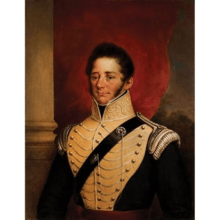George Taylor Denison
Captain George Taylor Denison (December 29, 1783 – December 18, 1853) was a British-born landowner, military officer and community leader in Upper Canada (later Canada West).[1][2]
George Taylor Denison | |
|---|---|
 | |
| Born | December 29, 1783 England |
| Died | December 18, 1853 (aged 69) Toronto, Canada West |
| Resting place | St. John's Cemetery on the Humber, Weston, Ontario |
| Occupation | Landowner, military officer |
| Spouse(s) | 4 |
| Children | 13, including George |
Life and career
He was born in England, the son of Captain John Denison and Sophia Taylor.[3][2] He traveled to Upper Canada and the town of York, Upper Canada, in 1796 with his parents and two brothers. He inherited the bulk of his family's property and, after the War of 1812, purchased and acquired land through marriage around what is now the Kensington Market neighborhood of Toronto. At the end of his life, he held 556 acres (2.25 km2) in York and was one of the wealthiest landowners in Canada West.[4][5] He married four times and fathered thirteen children; he wed Esther Borden Lippincott (daughter of Richard Lippincott) in 1806, Maria Taylor in 1828, Elizabeth Eleanor Caldwell in 1835, and Mary Priscilla Coates in 1850.
In 1815, he built an estate named Belle Vue (including an orchard and farm) on the south side of Russell Creek, which followed the style of Georgian architecture.[2] The 156-acre (0.63 km2) property on which he built his new home, lot 17 and the eastern portion of lot 18 ran north from present day Queen Street West to Bloor Street, and west from Lippincott Street to Augusta Avenue. Belle Vue (where the Kiever Synagogue now stands across from Denison Square) stood at the head of a mile-long carriage path, which is now Denison Avenue.
He served with the British militia in the War of 1812 and, from 1822 to 1837, organized and financed a voluntary cavalry troop, which he commanded during the Rebellions of 1837.[6] The troop later became the Governor General's Horse Guards. In 1846, he was given command of the 4th Battalion of the Toronto militia, a post he held until his death at Toronto in 1853. Denison is buried at St. John's Cemetery on the Humber in Weston, Ontario.[7]
Legacy
As a result of Denison's vast land holdings and the large number of children that he fathered, the Denison family featured prominently in the early history of Upper Canada and Ontario. Denison family names abound in the area, including the present-day names of Denison Square, Denison Avenue, Bellevue Avenue, as well as Major, Robert, Borden and Lippincott streets.
His grandson George Taylor Denison III was an officer in the army of the new Dominion of Canada and later served as a Toronto city councillor.
See also
References
- Chisholm, Hugh, ed. (1911). . Encyclopædia Britannica. 8 (11th ed.). Cambridge University Press. p. 22.
-
"Kensington Market, Toronto". Exploring Ontario. 2016. Retrieved 2019-06-08.
George Taylor Denison would continue to accumulate land around York, (Toronto) through purchase and marriage (Esther Borden Lippincott in 1806) and would become one of the wealthiest landowners in Upper Canada.
- "The Denison Family Tree". www.denisonfamily.on.ca. Retrieved September 26, 2013.
-
David Gagan. "DENISON, GEORGE TAYLOR (sometimes designated as George T. Denison Jr, George T. Denison II, or George T. Denison of Rusholme, to avoid confusion with his father and eldest son)". Dictionary of Canadian Biography. Retrieved 2019-06-08.
George Taylor Denison’s grandfather, John, was among the first inhabitants of York. He established the family’s position as minor landed gentry, a status that was enhanced by his son G. T. Denison of Bellevue who, at his death in 1853, was reputedly the wealthiest private landholder in Canada West.
-
"The Denisons". Kensington Market Historical Society. Retrieved 2019-06-08.
In 1815, after his service in the War of 1812, George purchased park lots 17 and 18, the location of modern day Kensington Market. That same year, he started the construction of his home Bellevue at the corner of Bellevue Square park, the modern location of the Kiever synagogue, which was roughly the center of his property.
-
"Bellevue". Lost Rivers of Toronto. Retrieved 2019-06-08.
George Denison, like many of the other Denisons, was a military man and loyal to the British Empire. He served with the militia in 1812, beginning a lifelong affiliation with Upper Canada’s military. From 1822 to 1837, Denison organized and led a voluntary cavalry troop, mostly at his own expense, which he commanded during the Rebellion of 1837. The troop later became the Governor General’s Horse Guards, the first eight commanding officers of which were Denisons. In 1846, George took command of the 4th Battalion of Toronto militia. He held this post until his death in 1853.
- Saint John's Cemetery on the Humber
- Lundell, Liz (1997). The Estates of Old Toronto. Boston Mills Press.
External links
- Denison Family of Toronto – family website